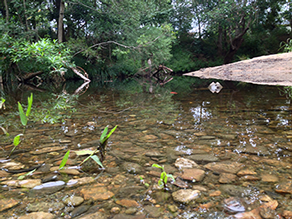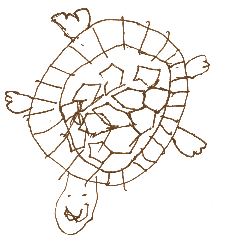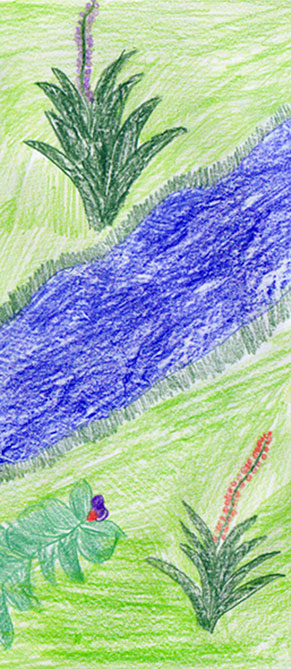
Sam, age 6
Habitat
Where is Fish Creek?
Fish Creek can be found in The Gap, South-East Queensland, Australia and forms part of a group of waterways that join up to the Brisbane River. Brisbane River is the longest river in South-East Queensland and flows out into Moreton Bay. Starting in the hills that surround The Gap, stormwater run-off and overland water flows come together to form an open stream at Wittonga Park, near Hilder Road. From here, Fish Creek flows through The Gap, and meets Enoggera Creek, near Walton Bridge Reserve.
What does biodiversity mean?
Plants and animals depend on each other to survive. The word biodiversity is a shortened version of two words put together: “biological” and “diversity”. When the word “biodiversity” is broken down into its parts, it tells us its meaning:
- Bio means “life”; and
- Diversity means “a variety of things”.
Biodiversity, therefore, is the variety of all living things and their relationships to each other.
What is an ecosystem?
Ecosystem is short for the words “ecological system”. An ecosystem includes all the living organisms that exist together in a particular area. All these living things interact with each other and with the non-living elements in the area. Non-living elements in the area include things like water, soil, the climate and so on. In short, the ecosystem is the blend of living things interacting with each other and the non-living world all-around it. An ecosystem can be small, like a puddle, or it can be large, like a river, a desert or even an ocean.
What is a habitat?
A habitat is the area (or surrounding environment) where animals or plants normally live or grow. Different animals and plants need different habitats to survive and thrive. Many animals and plants will often share and live in the same habitat.
What sort of habitat does Fish Creek have?
Fish Creek has a riparian and aquatic habitat.
A riparian habitat includes all the wildlife found along the banks of a creek, river, lake or other body of water.
Riparian habitats can be found where ever there is an interface between land and a body of water. Fish Creek’s riparian habitat is located in an urban environment.
An aquatic habitat is simply a place where aquatic (water) species live.
Why are riparian and aquatic habitats important?
Riparian and aquatic habitats are a very important part of our world’s environment. This is because lots of plants and animals live in them. For instance, Brisbane City Council estimates that waterways and their riparian habitats around Brisbane are home to over 1500 different plant species. This is a huge amount – more plant species than what the whole of England has!
Just some of the reasons we should care about our habitats include:
- Reduce erosion: The roots of plants that grow along the side of the creek stabilise the soil and collect sediment. This helps to stop the water’s edge being washed away.
- Improve water quality: Plants in the riparian and aquatic zone help to filter and purify water that can be used for drinking or recreational purposes.
- Support biodiversity: Riparian and aquatic habitats are home to lots of different types of plants, and support a huge range native wildlife. This includes insects, reptiles, birds, mammals, micro-organisms, invertebrates, frogs and fish.
- Improve our environment: Trees and other plants in riparian areas regulate greenhouse gases. This improves the health of our world.
- Improve water storage: A healthy riparian habitat allows plants and the soil to soak up and store water during heavy rain. This can help to prevent flooding.
What is a healthy riparian and aquatic habitat?
A healthy riparian and aquatic habitat is one that has a balanced ecosystem. All plants and animals live harmoniously together. There are no problems with over-population, pollution, or a decrease in food supply or water resources.
What is an unhealthy riparian and aquatic habitat?
In a healthy riparian and aquatic habitat, a happy balance exists between the plants and animals that live there.
In an unhealthy riparian and aquatic habitat, the opposite occurs – the habitat becomes imbalanced. The water may become polluted and animal/plant populations may decrease. Sometimes a couple of animals or plants may increase numbers in a way that can hurt other plants and animals also living in the area. The soil may wash away and weeds may overtake the native plants that grew there earlier.
Sadly, Fish Creek habitat became unhealthy. Weeds took over the native plant life, the water became polluted and the sides of the creek became steeper than what they should be.
The good news is that people all around The Gap are working together to restore local riparian and aquatic habitats. This is making Fish Creek habitat and local environment a lot healthier!

Fish Creek meets Enogerra Creek, The Gap

Pipi, age 5

Eleanor Free, age 9
